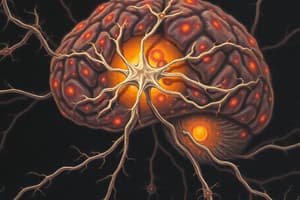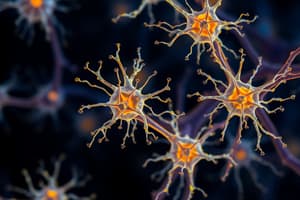Podcast
Questions and Answers
A researcher is investigating a new drug that aims to reduce anxiety. Which brain structure, known for its role in processing fear and aggression, would be of particular interest when assessing the drug's effectiveness?
A researcher is investigating a new drug that aims to reduce anxiety. Which brain structure, known for its role in processing fear and aggression, would be of particular interest when assessing the drug's effectiveness?
- Amygdala (correct)
- Cingulate Gyrus
- Thalamus
- Hippocampus
A patient exhibits difficulties in initiating and controlling voluntary movements, along with increased involuntary movements. Which of the following brain areas is most likely affected, based on these symptoms?
A patient exhibits difficulties in initiating and controlling voluntary movements, along with increased involuntary movements. Which of the following brain areas is most likely affected, based on these symptoms?
- Hippocampus
- Basal Ganglia (correct)
- Cerebellum
- Cerebral Cortex
A scientist is studying how chronic stress impacts gene expression in rats. They observe changes in the structure of DNA that either increase or decrease gene activity, without altering the underlying DNA sequence. Which mechanism are they most likely investigating?
A scientist is studying how chronic stress impacts gene expression in rats. They observe changes in the structure of DNA that either increase or decrease gene activity, without altering the underlying DNA sequence. Which mechanism are they most likely investigating?
- Epigenetics (correct)
- Transgenesis
- Polymorphism
- Genetic Mutation
During a study, researchers need to examine the real-time effects of a potential neurotoxin on the central nervous system. To directly assess the toxin's impact on neurotransmitter levels and overall brain health, which bodily fluid would be the MOST informative to analyze?
During a study, researchers need to examine the real-time effects of a potential neurotoxin on the central nervous system. To directly assess the toxin's impact on neurotransmitter levels and overall brain health, which bodily fluid would be the MOST informative to analyze?
Researchers are using CRISPR-Cas9 technology to investigate the role of a specific gene in the development of Alzheimer's disease. What is the MOST likely goal of using this gene-editing technique in their study?
Researchers are using CRISPR-Cas9 technology to investigate the role of a specific gene in the development of Alzheimer's disease. What is the MOST likely goal of using this gene-editing technique in their study?
Which of the following glial cell functions directly supports neuronal communication by regulating the environment around synapses?
Which of the following glial cell functions directly supports neuronal communication by regulating the environment around synapses?
How would damage to the cerebellum most likely present?
How would damage to the cerebellum most likely present?
After suffering a traumatic brain injury, a patient exhibits difficulty in initiating voluntary movements. Which area of the midbrain is most likely affected?
After suffering a traumatic brain injury, a patient exhibits difficulty in initiating voluntary movements. Which area of the midbrain is most likely affected?
Which of the following accurately describes the functional difference between the sympathetic and parasympathetic nervous systems?
Which of the following accurately describes the functional difference between the sympathetic and parasympathetic nervous systems?
A researcher is studying the flow of information in a neural circuit involved in decision-making. Which type of neuron would be most crucial for integrating information within a specific brain region in this circuit?
A researcher is studying the flow of information in a neural circuit involved in decision-making. Which type of neuron would be most crucial for integrating information within a specific brain region in this circuit?
A patient has damage to their medulla. What function would you expect to be impaired?
A patient has damage to their medulla. What function would you expect to be impaired?
What is the primary function of oligodendrocytes?
What is the primary function of oligodendrocytes?
If a neurosurgeon is about to make an incision on the top of the brain, which directional term should they be aware of?
If a neurosurgeon is about to make an incision on the top of the brain, which directional term should they be aware of?
Flashcards
Neurons
Neurons
Fundamental units of the nervous system that generate action potentials and communicate via neurotransmitters.
Dendrites
Dendrites
Receive signals from other neurons.
Axon
Axon
Carries signals away from the soma to other neurons or target cells.
Sensory Neurons (Afferent)
Sensory Neurons (Afferent)
Signup and view all the flashcards
Interneurons
Interneurons
Signup and view all the flashcards
Motor Neurons (Efferent)
Motor Neurons (Efferent)
Signup and view all the flashcards
Oligodendrocytes
Oligodendrocytes
Signup and view all the flashcards
Somatic Nervous System
Somatic Nervous System
Signup and view all the flashcards
Periaqueductal Gray (PAG)
Periaqueductal Gray (PAG)
Signup and view all the flashcards
Blood-Brain Barrier (BBB)
Blood-Brain Barrier (BBB)
Signup and view all the flashcards
Polymorphisms
Polymorphisms
Signup and view all the flashcards
Methylation
Methylation
Signup and view all the flashcards
CRISPR-Cas9 Gene Editing
CRISPR-Cas9 Gene Editing
Signup and view all the flashcards
Study Notes
- The nervous system comprises neurons and glial cells, exploring its divisions and understanding brain structures, functions, genetics, and their impact on neuroscience.
Cells of the Nervous System
- Neurons are the fundamental units of the nervous system, with approximately 90-100 billion in the human brain.
- Neurons generate action potentials and release neurotransmitters for communication and process motor, sensory, and cognitive information.
Structure of a Neuron
- Dendrites receive signals from other neurons.
- The soma (cell body) contains the nucleus and cellular components.
- The axon transmits signals away from the soma.
- Axon terminals release neurotransmitters into the synapse.
Functional Types of Neurons
- Sensory Neurons (Afferent) carry sensory information to the CNS.
- Interneurons connect neurons within the same neural region.
- Motor Neurons (Efferent) carry signals away from the CNS to muscles/glands.
Glial Cells
- Oligodendrocytes form myelin in the CNS.
- Astrocytes form the blood-brain barrier, respond to neuronal injury (gliosis), and provide nutrients for neurotransmitter synthesis and maintain ion balance
- Microglia act as immune cells, removing waste.
- Ependymal cells produce cerebrospinal fluid (CSF).
The Nervous System: Terminology & Divisions
- The neuraxis is the central axis of the nervous system.
Directional Terms
- Anterior - Posterior (Front - Back)
- Dorsal - Ventral (Top - Bottom)
- Medial - Lateral (Middle - Side)
- Superior - Inferior (Above - Below)
Peripheral Nervous System (PNS)
- The Somatic Nervous System controls voluntary muscle movements.
- The Autonomic Nervous System (ANS) controls involuntary functions.
- The Sympathetic Nervous System is responsible for "fight or flight" responses, releasing norepinephrine.
- The Parasympathetic Nervous System enables "rest and digest" functions by releasing acetylcholine.
- The Enteric Nervous System regulates digestion.
Central Nervous System (CNS)
- The Hindbrain includes the medulla, pons, and cerebellum.
- The Medulla regulates breathing, heart rate, and reflexes.
- The Pons connects brain regions and affects arousal/sleep.
- The Cerebellum controls balance, coordination, and motor timing.
- The Midbrain includes the superior and inferior colliculus, substantia nigra, ventral tegmental area (VTA), and periaqueductal gray (PAG).
- The Superior Colliculus controls visual tracking.
- The Inferior Colliculus processes auditory information.
- The Substantia Nigra produces dopamine and regulates movement (affected in Parkinson's disease).
- The Ventral Tegmental Area (VTA) is important for reward processing.
- The Periaqueductal Gray (PAG) regulates pain and is rich in endorphins.
- The Forebrain includes the thalamus, hypothalamus, limbic system, cerebral cortex, nucleus accumbens, and basal ganglia.
- The Thalamus serves as a sensory relay station.
- The Hypothalamus regulates hormones, hunger, temperature, etc.
- The Limbic System controls emotion and memory.
- The Cingulate Gyrus processes pain and emotions.
- The Hippocampus is involved in memory formation.
- The Amygdala is responsible for fear and aggression.
- The Olfactory Bulb processes smells.
- The Nucleus Accumbens is part of the reward system.
- The Cerebral Cortex enables higher cognitive functions.
- The Occipital Lobe controls vision.
- The Temporal Lobe handles hearing and language.
- The Parietal Lobe involves sensory processing.
- The Frontal Lobe relates to decision-making, personality, and movement.
- The Basal Ganglia stabilizes voluntary movement and regulates habitual movement.
Cerebral Blood Flow & Cerebrospinal Fluid (CSF)
- Cerebral blood flow is essential for normal brain function.
- The Blood-Brain Barrier (BBB) controls substances entering the brain from the bloodstream.
- Cerebrospinal Fluid (CSF) is produced in the ventricles, provides cushioning and nutrient transport, and its analysis helps in drug and neurotransmitter studies.
Genetics & the Nervous System
- The nucleus contains 46 chromosomes, made of DNA.
- Genes are segments of DNA that determine traits.
- Polymorphisms are gene variations that influence traits like enzyme production and neurotransmitter levels.
- Gene expression can be modified without changing the DNA sequence.
- Methylation: Tightly wound DNA (gene off).
- Acetylation: Loosely wound DNA (gene on).
- Transgenic Animals are modified to study gene function, either globally (whole-body gene change) or conditionally (specific area/time change).
CRISPR-Cas9 Gene Editing
- CRISPR-Cas9 is a technique to edit genes or turn them on/off.
- It could be used for treating genetic disorders.
Studying That Suits You
Use AI to generate personalized quizzes and flashcards to suit your learning preferences.
Related Documents
Description
Explore the nervous system's fundamental components: neurons and glial cells. Understand neuron structure, including dendrites, soma, and axon terminals. Learn about sensory, inter, and motor neuron functions within the nervous system.





